Dallol, Ethiopia, a landscape of sulfur lakes and insanely hot springs. Located in the Danakil Depression inside the Afar region of Ethiopia, it’s probably the most alien-like landscape that exists on our planet. Frequently compared to red Mars and the yellow planet Venus, it truly is a site of extraterrestrial features and unearthly facts. Dallol, Ethiopia and its surrounding area, the Danakil depression, have been named ‘alien-looking’ a lot of times by those who visit these areas.
“Ethiopia’s Danakil Depression is a bizarre landscape worthy of the superlatives tossed at it. Hottest. Driest. Lowest. Weirdest.”
The National Geographic magazine wrote about the Danakil depression
Mars VS Dallol
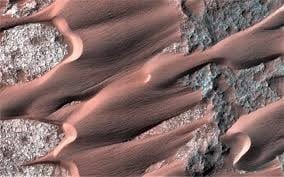
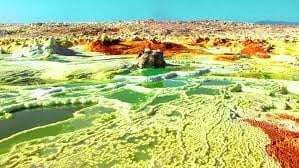
Nili Patera caldera, Mars – a dune field located on top of the lava bed of an ancient volcano near the Martian equator. Despite some allegations that deposits of Silica have been found around the area which might suggest that sing-celled life could have possibly existed on Mars, it is now, by no means, a place where life can survive let alone thrive.
Venus VS Dallol

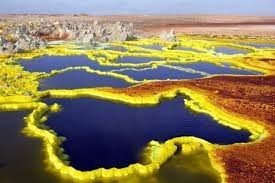
Venus, the yellow planet. And the brightest and hottest planet in the solar system, with thick clouds of sulfuric acid that give it a yellowish color. Called the twin of Earth due to its similarity with our planet, space.com named it ‘The hot, hellish & volcanic planet.’
“Danakil Depression, Ethiopia — In oppressively dry heat and a miasma of sulfur and chlorine, the rocky landscape sprouts patches of neon green and yellow that resemble oozing scrambled eggs.”
The New York Times published an article named ‘Gazing into Danakil depression’s mirror, and seeing Mars stare back’.
Dallol is found inside the Danakil Depression, the northern part of the Afar Triangle or Afar Depression. Found 125 meters below sea level, it is one of the lowest points on Earth. Dallol mountain has a height of 60 meters above the salt surfaces that surround it.
The word ‘Dallol’, in the language of the Afar people that live in the area, means dissolution or disintegration, pointing to the brine and acidic liquids that pour out of the hot springs of Dallol.
Dallol’s temperature goes as far high up as 125 degrees Fahrenheit (51.7 degrees Celsius) and its average daily temperatures of 93.9 degrees Fahrenheit (34.4 degrees Celsius) make it the hottest place on Earth.
A Hydrothermal Environment: The Reason Behind The Harshness Of Dallol’s Weather
A landscape that is so bizarre it’s been named ‘an alien landscape’, closer in its geology to planets Venus and Mars than to its home planet Earth. Every footage of the area has a habit of looking as if its colors have been twitched by an editor with a peculiar taste in colors. But, fascinations aside, what makes Dallol such a strange place, and what exactly is the science behind its utterly consistent Harshness?
This Wikipedia article portrays Dallol as a “unique, terrestrial hydrothermal system.”
And what exactly is a hydrothermal system? A hydrothermal system simply means the circulation of hot water in the most general sense. This circulation of water can take place in locations of extreme heat beneath the Earth’s crust or inside the ocean floors. In the case of Dallol, it’s the former case and is known as a terrestrial hydrothermal system.
Here’s a rather simple explanation of a terrestrial hydrothermal environment:
“Terrestrial hydrothermal environments are those settings where fluids discharge either at or close to the land surface at a temperature that is significantly above the local ambient air temperature. The hydrothermal processes transfer heat and dissolved matter to the surface in a liquid or vapor (gas) phase. Those fluids originate at variable depths below the Earth’s surface and have a wide range of temperature and chemical composition.”
A hydrothermal environment, by its nature, releases highly heated fluids containing minerals from the planet’s womb. This creates what is called a hot spring. Inside Dallol, a supersaturated brine (a solution of highly concentrated salts like sulfates) pours out through the openings of these hot springs, bringing with it unwelcomingly high hotness to Dallol’s temperature.
But, is there also an explanation for the strange colors we see on the outer surface of Dallol? The answer: yes, and the rationale comes from nowhere other than the chemistry of the element iron (Fe). This element exhibits multiple oxidation numbers, meaning it can react with the element oxygen in a lot of different ways to form different compounds.
In simple terms, different compounds mean different colors and iron can have a lot of different compounds with oxygen, giving a lot of different colors. The exterior of Dallol, having the element iron in abundance, can thus be seen as having colors that go from white and pale green to yellow, orange, and red.
Water Without Life: Debates And Discoveries On Dallol’s Shocking Fact

The mysteries of Dallol don’t just end at harsh climates and the looks of an alien planet. Its strangeness stretches even to questions and controversies about its habitability.
One group of scientists thinks they’ve found living microorganisms inside of the sulfur lakes of Dallol, Ethiopia, and suggest this might give important insights in understanding how life might develop in extraterrestrial bodies of harsh climate like Saturn’s moon Titan and the red planet, Mars.
Another group thinks life can’t develop inside the sulfur brines of Dallol and advise caution in our definition of what’s considered life.
Dr. Gomez’s team and their discovery about Dallol, Ethiopia
The following is the concluding remark of a nature magazine article published on May 27th, 2019 by Felipe Gomez from Astrobiology Center in Spain and his team of international researchers:
“We demonstrated the presence of living ultra-small microorganisms in a multi-extreme environment with adverse conditions for life: extremely low pH (0.25), temperature (90 °C), redox potential, salinity, and heavy metals content. Molecular studies, electron microscopies observation, and phylogenetic analyses of amplified rDNA sequences showed the presence of ultra-small microorganisms related to the Order Nanohaloarchaea. The ultra-small bacteria observed in the samples were morphologically spherical and entombed in the mineral layers that form the small chimneys in Dallol under high acidity and high-temperature conditions. The saturation of salts and minerals in the superheated water, which results in precipitation and the formation of the chimneys may be influenced by entombed microorganisms. We described the presence of ultra-small microorganisms in a natural environment which is an Earth analog of some regions of Mars such as Nili Patera Caldera. The presence of life in the Dallol hot springs expands our understanding of the limits of habitability on Earth and beyond. However, future work is needed to understand how these nanobacteria survive in such an extreme environment and whether they play a role in geochemical cycling.”
What this means, in ordinary terms, is that the scientists say they’ve found life forms amidst the saline lakes of the Dallol hydrothermal area.
This led the BBC into publishing this article titled ‘In Earth’s hottest place, life has been found in pure acid.’ This finding had implications that left the scientific community optimistic about the possibility of life on other planets with almost the same landscape and weather as Dallol.
Barbara Cavalazzi from the University of Bologna, Italy was a part of the scientific discovery and stresses the similarity of Dallol’s weather and landscape to that of Mars. She told the BBC in 2017:
“On Mars, you have mineral deposits and sulfate deposits similar to those seen in the Danakil Depression. You also have active brine flowing periodically.”
Another thing to note about the implications of this study is its importance in the effort to understand how life might have first formed in the earlier days of our planet, while its atmosphere and landscape were still full of hot and acidic substances. Back then, the whole earth was much like Dallol, and understanding just how any life form can survive inside the lakes of Dallol, Ethiopia could give scientists insights to be carried into studies of life formation on early Earth.
Dr. Gomez, in his talk with the New York Times, said that the aim of the search for extremophiles (microorganisms that live in multi-extreme conditions of temperature, acidity, alkalinity or chemical concentration), is “to try to know the limits of life and the possibility of such forms of life in other planets like Mars.”
Another, and a wider purpose of inquiring the techniques with which to identify life in extreme environments is to try to define the questions, “What is life? What are the limits of life? And if we find life on other planets, would we be able to recognize it?”
Here, it’s important to note that there isn’t a central definition of life. There’s no consensus among scientists on what should be called life. Funnily enough, even NASA doesn’t have an official definition of life, and yet most of its recent missions to space have been focused on finding extraterrestrial life forms. In its article titled, ‘Are aliens hiding in plain sight?’, the Guardian wrote the words of zoologist Arik Kershenbaum of the University of Cambridge:
“NASA needs a definition of life so it knows how to build detectors and what kinds of instruments to use on its missions.”
Biologists all over the world are trying to find ways to come to a consensus on the definition of life, and the expedition to Ethiopia’s Dallol is one of these works. But, until a clear definition is established, here’s NASA’s unofficial working definition of life:
“A self-sustaining chemical system capable of Darwinian evolution.”
The above discovery could’ve helped the efforts towards a clearer understanding of life, but, it wasn’t long before this discovery turns into a controversy.
Lopez Garcia’s team and their discovery about Dallol, Ethiopia
The controversy starts with the publishing of a second article on nature ecology & evolution reflecting an opposing view on the area’s habitability.
Lopez García, from the second team of scientists that refuted the previous article’s findings, spoke to Spain’s Information and Scientific News Service (SINC), saying:
“After analyzing many more samples than in previous works, with adequate controls so as not to contaminate them and a well-calibrated methodology, we have verified that there’s no microbial life in these salty, hot, and hyperacid pools or in the adjacent magnesium-rich brine lakes.”
This second article, published on October 28th, 2019, just months after the first article’s claim that there exists life on Dallol, has strange implications.
For one, Dallol, Ethiopia, might just be the only known place on Earth that doesn’t support life. This, added to the list of strange facts of Dallol, makes the area even more alien-like.
A second implication is that the existence of sterile water on Dallol’s lakes that support no life forms whatsoever make the area the only known place on Earth with water, but no life. Now, this has a rather bigger meaning than we might notice at first glance. And this meaning doesn’t just stay at the study of life on Earth. It goes even to astrobiology and the search for alien life, given that the area has been seen as an analog to other planets.
For a lot of reasons, looking for evidence of life on other planets is a tricky subject. For one, humans cannot yet travel to other planets to see for themselves. And two, our telescopes aren’t powerful enough to detect life forms directly, either. Rather, a method used by NASA and other space stations when studying the existence of life on other planets is to look for certain chemicals that can imply that there exists life on the planet. Look, for example, the following excerpt from an article published by NASA, explaining how their scientists look for life on planets outside our solar system:
“Answering the question of whether life exists elsewhere in the universe is beset with technical challenges. We can’t yet travel to planets around other stars, called exoplanets, to see for ourselves. Nor are our telescopes powerful enough to see their surfaces.
Instead, astronomers look to an exoplanet’s atmosphere, scouring it for traces of chemicals associated with life. Water, methane, oxygen, ozone, and other so-called biomarkers produce unique patterns of light that telescopes can detect from afar.”
But, the findings of the team led by Lopez García pose a question even on the techniques we use in the hunt for life on exoplanets. The sterile waters of Dallol’s lakes are proof on our planet that the presence of water, which, as we saw above in NASA’s article, is a basic habitability criterion for exoplanets, doesn’t directly imply the existence of life.
This dispute over whether or not life exists on Dallol continues to this day without further studies to clear the confusion. But until newer studies are conducted and the fog lifted off of our eyes, we’re left to wonder which side might just be correct.
The White Gold (Amole): Beyond Dallol’s Extreme Temperature
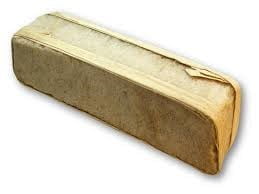
Strangeness at its best. An alien landscape right on the face of our own Earth. But, Dallol has more to offer than weird looks and inhospitable surfaces. For the people of Ethiopia, it’s produced blocks of salt for centuries, once used as currency and referred to as Ethiopia’s ‘white gold.’
Slabs of salt mined traditionally by the Afar people from the Dallol area are unloaded in a town called Berahile, Ethiopia. The blocks of salt would have to be transported from the mining sites on caravans of camels, despite Dallol’s temperature of an unforgiving nature.
Berahile is where the blocks of salt change the mean of transportation, from the backs of camels to trucks. The trucks then move the salt to Mekelle, the capital of the Tigray region in Ethiopia. The salt unloaded and sold here is then distributed all across the country, making the city crucial in the salt trade route.
Decades earlier, Amole, the salt currency of Ethiopia, would have been made here and distributed to all parts of the nation.
The Amole has been gone for years, and it now seems this centuries-old salt trade route might just go extinct, too. Paved roads are being constructed in the area as a substitute for the camel caravans and industrialized mining is taking over, replacing traditional mining practices of the Afar people.
The region, previously part of the Red Sea, is occasionally flooded by the same sea. The last flood happened 30,000 years ago, leaving behind rich salt deposits the Afar people mine to this day.
Dallol, Ethiopia: The Ghost Town Next To Hell
On the map, Dallol is an abandoned settlement located inside administrative zone 2 of the Afar region of Ethiopia. Currently holding the highest recorded temperature (34 degrees Celsius, recorded during the years 1960 to 1966) for an inhabited area in the whole world, it’s so near to the Dallol geothermal area that it’s no longer believed to have people living inside it. The Central Statistical Agency has not published an estimate of this settlement’s population for years and it’s been described as a ghost town. The town is home to an abandoned potash mining site and a railway that once extended to the port of Mersa Fatma, Eritrea.
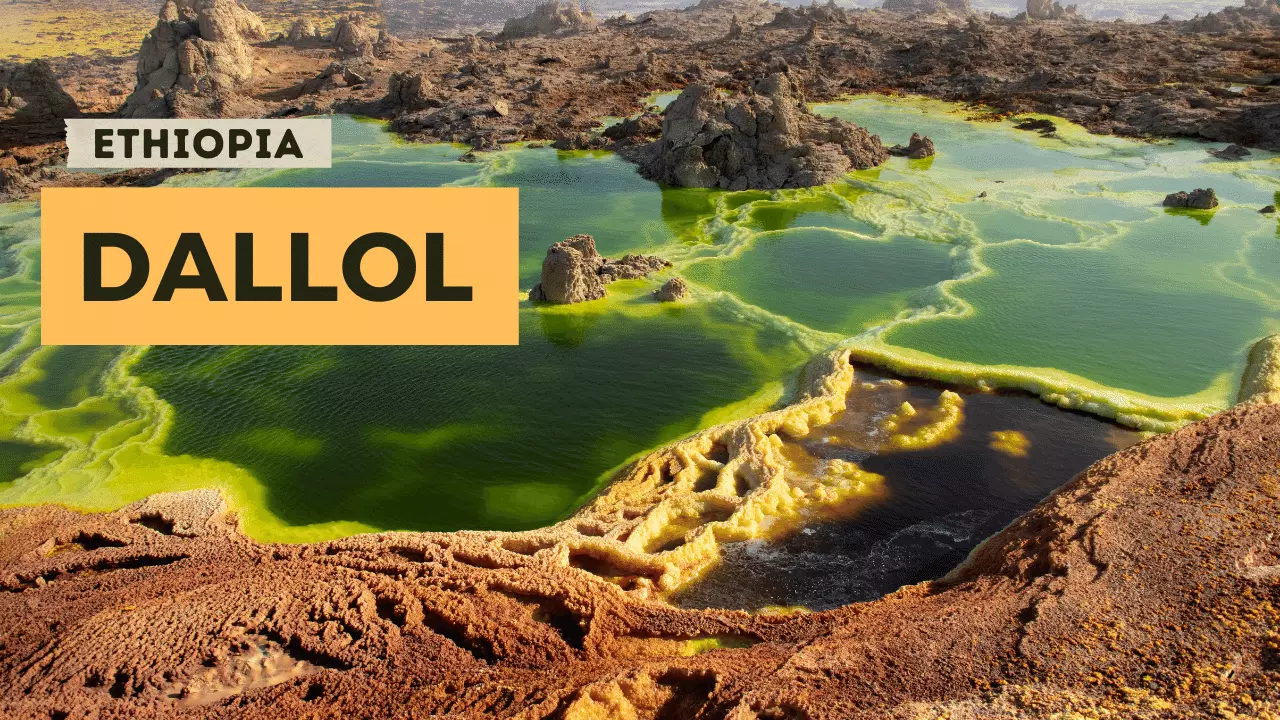








0 Comments